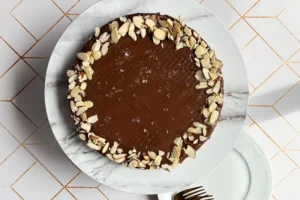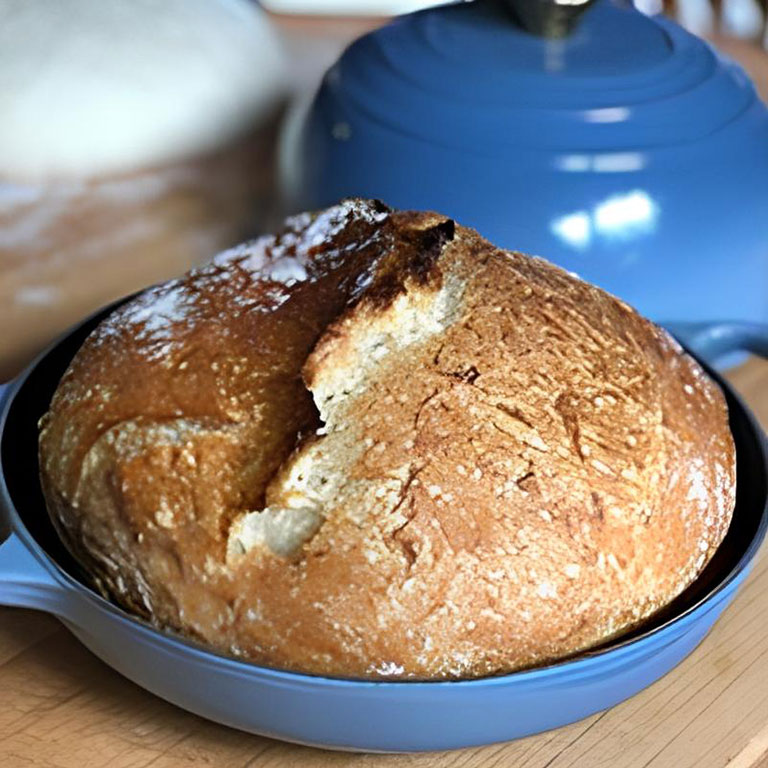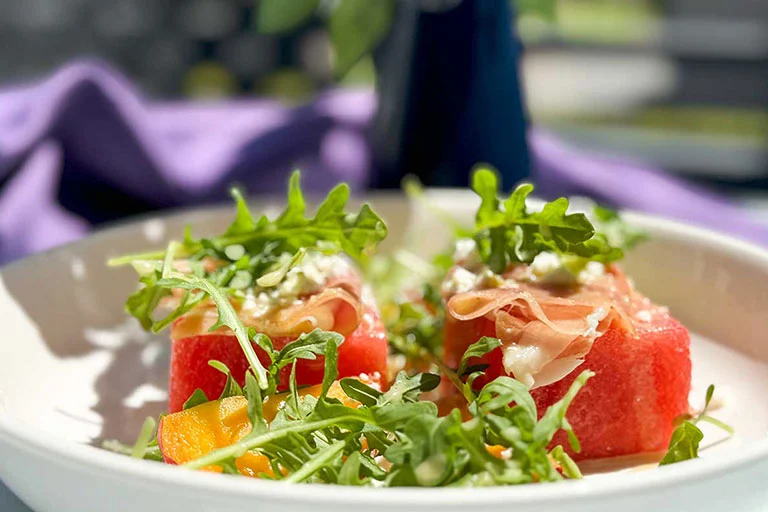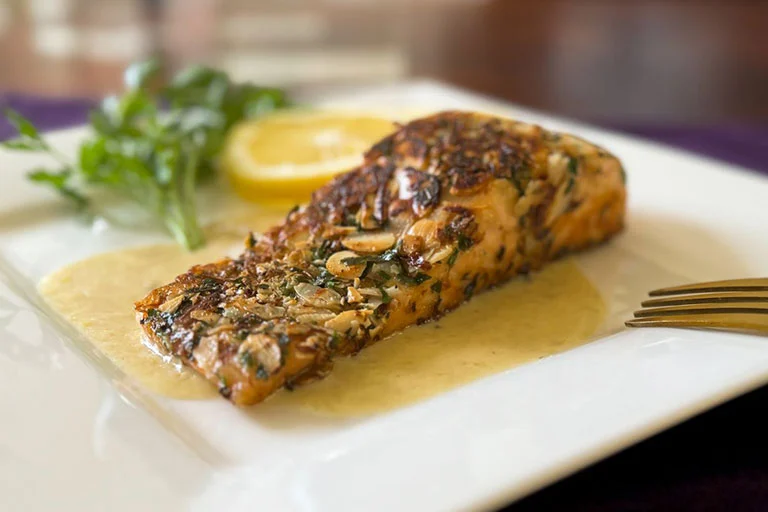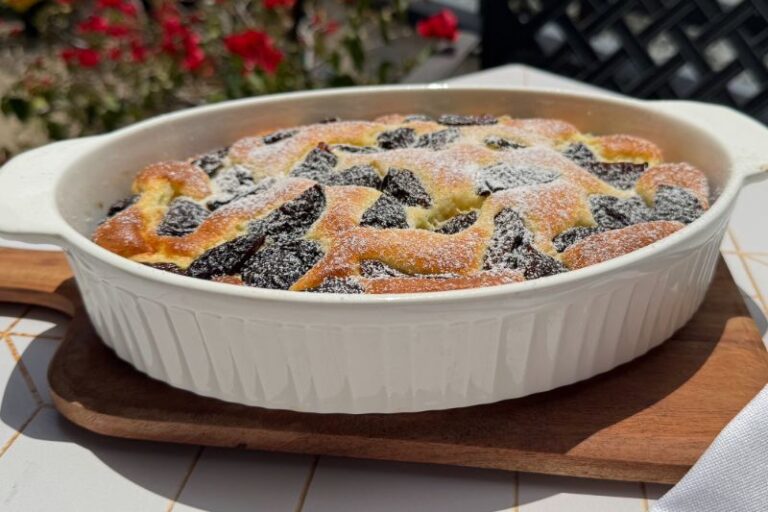
Clafoutis aux Prunes: A Delightful French Dessert with a Healthy Twist
I’m excited to share this recipe. I have grown so fond of prunes (DON’T exit just yet) that I’ve been experimenting using them in all kinds of recipes. If you haven’t tried them in a while, I think you are in for a treat. They are so underrated that I made it my personal mission to work them into recipes. I personally have a handful everyday (you’ll see why down in the health benefits section.)
While I’ve always loved French Clafoutis (usually with cherries or plums), I never tried making one with dried fruit. The resulting Prune Clafoutis (Clafoutis aux prunes) has now become a favorite. I served this at a recent dinner with friends, and they loved it! I added a few healthy tweaks to the original recipe, of course, and my Weight Watcher guests really appreciated the effort. They got a delicious, healthier version of a traditional French dessert for just 4 points.
If you’re not familiar with clafoutis (pronounced klah-foo-TEE), you’re in for a treat. A clafoutis is a French dessert that is part flan, part Dutch baby, and absolutely delicious when studded with tender, sweet prunes. It’s a rustic yet elegant dish that’s surprisingly simple to make but impressive enough to serve to guests.
In this modern version, I’ve substituted fat-free Greek yogurt for milk, which gives this Dutch baby-like dessert a nicer flavor and added protein. While the authentic French Clafoutis is originally made using unpitted cherries, I’ve used prunes for their natural sweetness and impressive health benefits (more on that later!).
I’ve also made some other modifications to create a lighter, fluffier version: substituting half of the all-purpose flour with almond flour for a nutty flavor and lower carb count, using a monk fruit sugar substitute instead of regular sugar, adding some vanilla extract, a pinch of baking powder, and folding in beaten egg whites for a nice fluffy batter that’s almost soufflé-like in texture.
But other than these tweaks, the rest of the recipe remains authentic to its French roots. Let’s dive in!
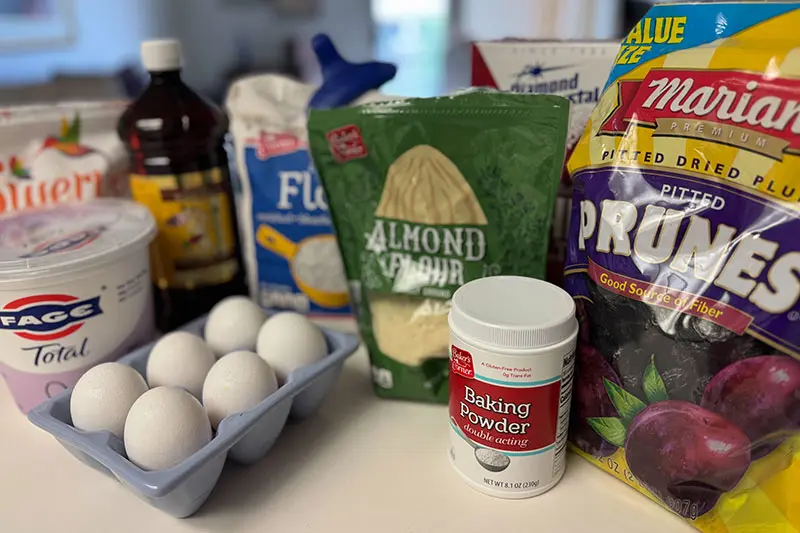
Ingredients
The Star Players
- Prunes: These sweet, chewy dried plums are the star of our clafoutis. California prunes tend to be plumper and more flavorful than other varieties. They provide natural sweetness and a wonderful texture contrast to the custardy base.
- Eggs: The backbone of any good clafoutis, eggs create that magical custard-like texture. We’ll be separating them to whip the whites for extra fluffiness.
- Sugar Substitute: I use either Lakanto monk fruit sweetener or Swerve to keep the carbs low while maintaining sweetness. These measure cup-for-cup like regular sugar.
- Non-Fat Greek Yogurt: A healthier substitute for traditional milk or cream, Greek yogurt adds protein and a subtle tanginess that balances the sweetness.
- Pure Vanilla Extract: Adds warmth and depth to the overall flavor profile of the clafoutis.
- Salt: Just a pinch enhances all the other flavors.
- All-Purpose Flour: Provides structure to the batter, but we’re using less than traditional recipes.
- Almond Flour: Creates a tender crumb and adds a subtle nutty flavor while reducing the overall carbohydrate content.
- Baking Powder: Just a touch helps the clafoutis rise and creates that light, airy texture.
- Monk Fruit Confectioner’s Sugar: For dusting the top of the finished clafoutis – a zero-calorie alternative to powdered sugar.
- Cooking Spray: To ensure the clafoutis doesn’t stick to the baking dish.
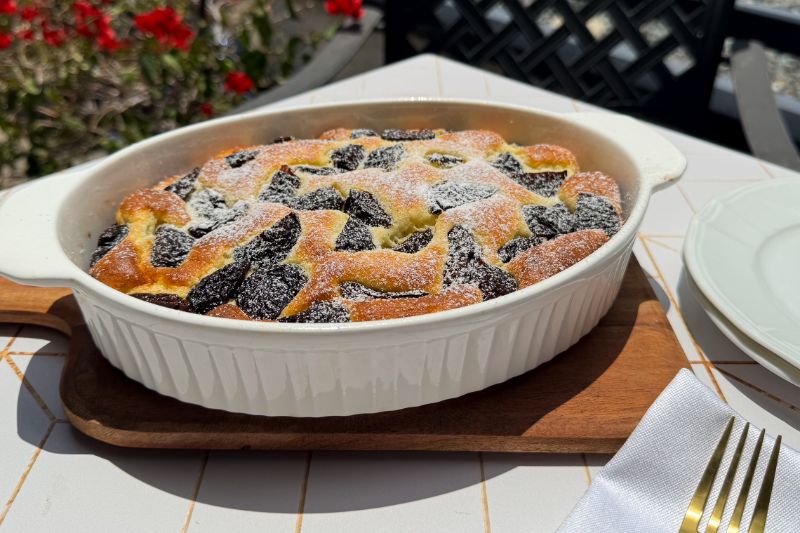
Substitutions and Variations
One of the wonderful things about clafoutis is its versatility. Here are some substitutions and additions you might consider:
- Fruit Options: While we’re using prunes today, clafoutis traditionally uses cherries. You can also use fresh plums, peaches, apricots, berries, or apples.
- Flour Alternatives: For a gluten-free version, replace all-purpose flour with a 1:1 gluten-free baking mix.
- Dairy Substitutions: Almond milk, coconut milk, or regular milk can replace the Greek yogurt.
- Flavor Enhancements: Add a teaspoon of almond extract for a beautiful complementary flavor, or some lemon or orange zest for brightness.
- Soaked Prunes: For an adult version, soak the prunes in Armagnac, brandy, or rum for at least 30 minutes (or overnight in the refrigerator) before adding them to the batter. The alcohol will infuse the prunes with wonderful flavor and plump them up beautifully.
- Add-ins: Sprinkle some sliced almonds on top before baking for added crunch, or add a dash of cinnamon or cardamom to the batter.
How to Make Prune Clafoutis
Creating this delightful dessert is simpler than you might think. Here’s a step-by-step guide:
- Preheat and Prepare: Start by preheating your oven to 350 degree F. Spray a 9-inch round or oval baking dish with cooking spray.
- Prepare the Prunes: Cut them in half.

- Separate the Eggs: Separate the eggs, placing the whites in one bowl and the yolks in another larger mixing bowl.
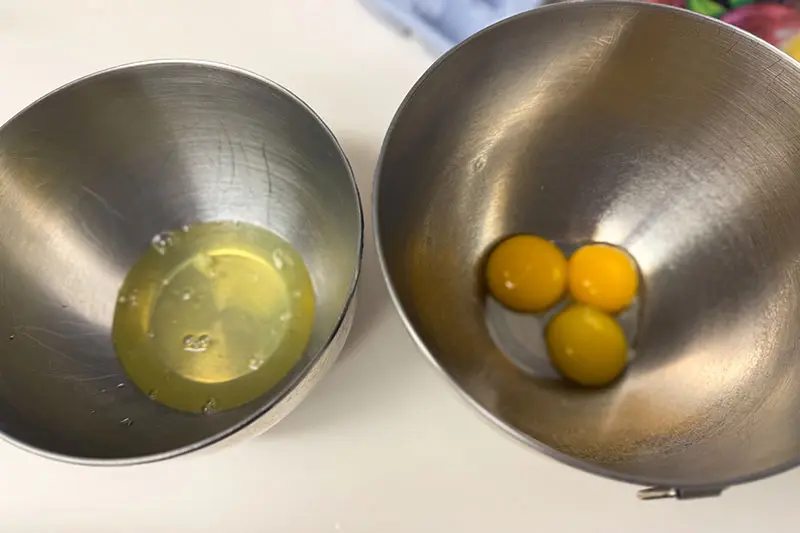
- Make the Base Batter: To the bowl with the egg yolks, add 4 tablespoons of the sugar substitute. With a hand mixer, beat until pale yellow in color and well combined. Add the Greek yogurt, vanilla extract, and a pinch of salt. Whisk until smooth.
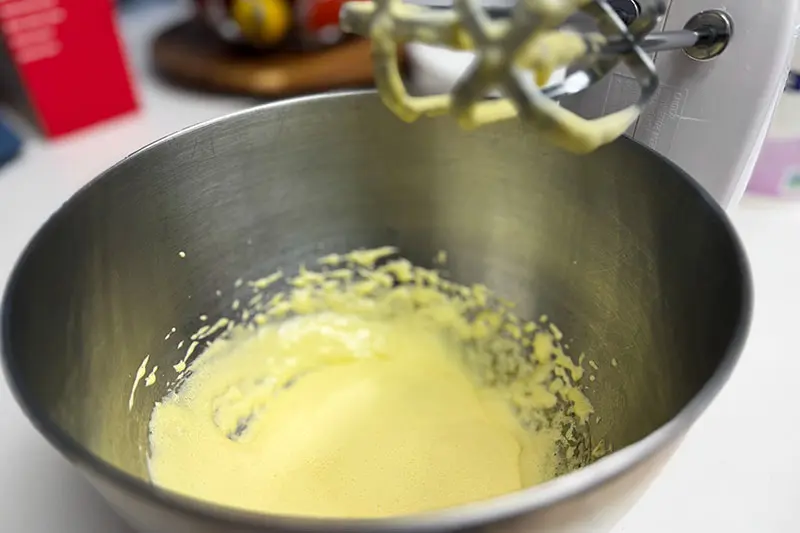
- Combine Dry Ingredients: Combine the dry ingredients in a bowl. Then, gradually add the mixture to the egg and sugar mixture. Stir to combine. Be careful not to overmix.
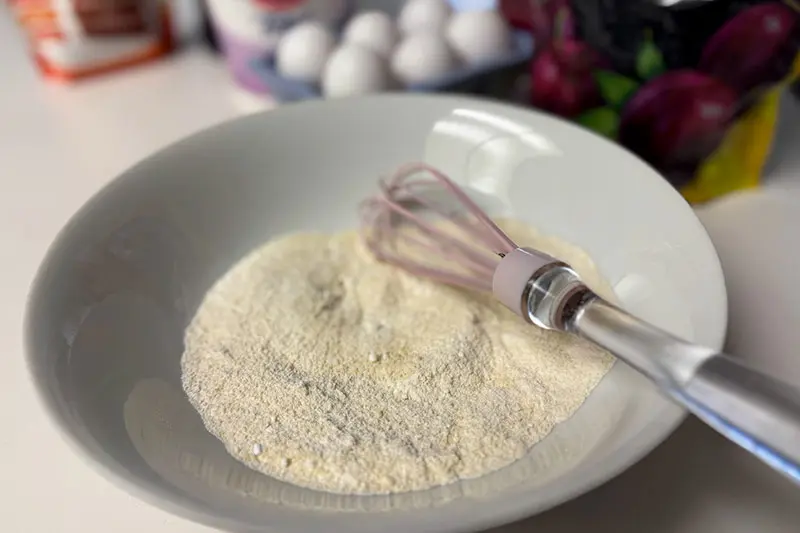
- Whip the Egg Whites: Using clean beaters, whip the egg whites until stiff peaks form.
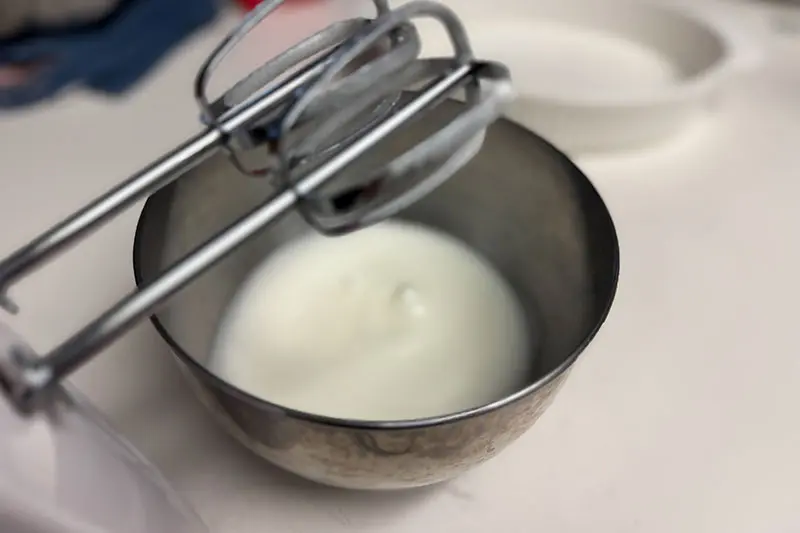
- Fold in Egg Whites: Gently fold the whipped egg whites into the batter using a spatula, maintaining as much air as possible.
- Pour and Bake: Pour the batter into the prepared dish. Arrange the cut prunes on top. Bake in the preheated oven for 30-35 minutes, or until the clafoutis is puffed, set in the center, and golden brown around the edges.

- Cool Slightly: Allow the clafoutis to cool for 10-15 minutes before serving. It will deflate slightly as it cools – this is normal!
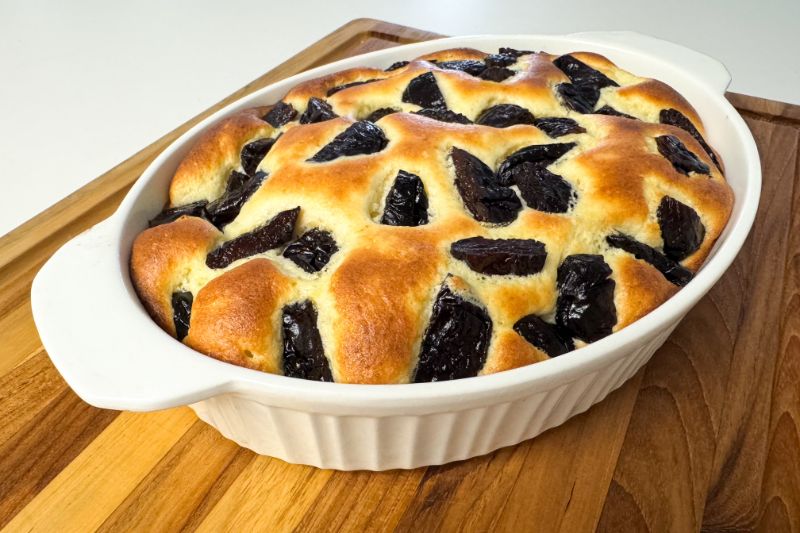
- Finish and Serve: Using a powdered sugar canister, dust with monk fruit confectioner’s sugar just before serving. The clafoutis can be served warm, at room temperature, or even cold.

How to Store Clafoutis
Clafoutis is best enjoyed fresh, but leftovers can be stored for later enjoyment. Here’s how:
- Refrigeration: Cover any leftover clafoutis with plastic wrap and refrigerate for up to 3 days.
- Reheating: To enjoy warm, reheat individual slices in the microwave for 20-30 seconds, or place the entire dish in a 300 degree F oven for about 10 minutes.
- Freezing: While possible, freezing is not recommended as the texture may become soggy when thawed. If you must freeze, wrap individual portions tightly and freeze for up to 1 month. Thaw overnight in the refrigerator before reheating.
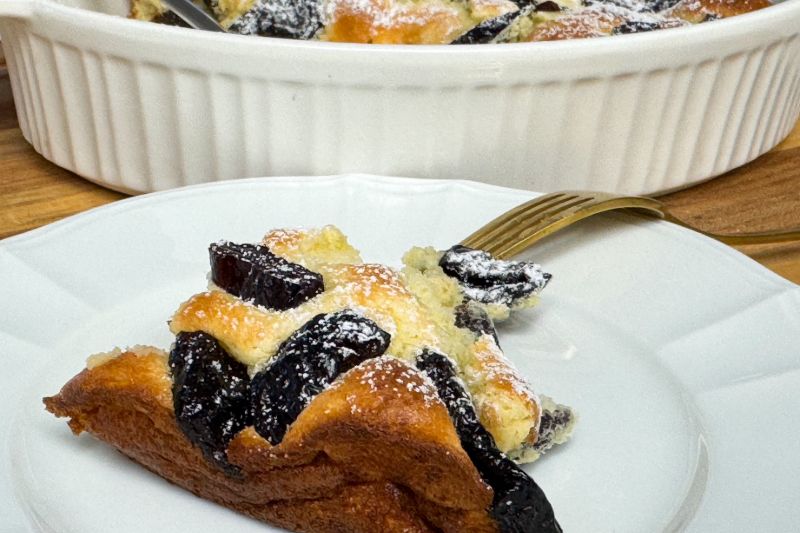
The Health Benefits of Prunes
While many people think of prunes primarily for their digestive benefits, these dried fruits offer a remarkable array of health advantages that make them a nutritional powerhouse. I had no idea that they could reverse bone loss, improve my hair and help my heart. Who knew and why isn’t there a marketing campaign promoting these babies? LOL
Digestive Health
Yes, the rumors are true! Prunes are excellent for digestive health. They contain both soluble and insoluble fiber, which helps maintain bowel regularity. According to a review published in the journal “Alimentary Pharmacology & Therapeutics,” prunes are more effective than psyllium for improving stool frequency and consistency. [Source: https://www.ncbi.nlm.nih.gov/pmc/articles/PMC6880808/]
Bone Health
Research from Penn State University has shown that prunes may help prevent or delay bone loss. A study published in “Osteoporosis International” found that postmenopausal women who consumed 100 grams of prunes daily for one year had significantly higher bone mineral density compared to those who didn’t eat prunes. [Source: https://www.bones.nih.gov/health-info/bone/bone-health/nutrition/prunes-and-bone-health]
Heart Health
Prunes are rich in potassium, which helps maintain healthy blood pressure, and their soluble fiber helps lower cholesterol levels. According to the American Heart Association, foods high in soluble fiber like prunes can help reduce the risk of heart disease. [Source: https://www.heart.org/en/healthy-living/healthy-eating/eat-smart/nutrition-basics/whole-grains-refined-grains-and-dietary-fiber]
Antioxidant Powerhouse
Prunes contain high levels of phenolic compounds that function as antioxidants, protecting your cells against damage from free radicals. Research published in “Critical Reviews in Food Science and Nutrition” highlights their exceptional antioxidant capacity. [Source: https://www.tandfonline.com/doi/abs/10.1080/10408398.2011.596097]
Blood Sugar Management
Despite their sweetness, prunes have a low glycemic index of 29, meaning they have a minimal impact on blood sugar levels. The journal “Nutrition Research” published findings that suggest prunes may help with blood sugar control due to their fiber content and specific nutrients. [Source: https://www.sciencedirect.com/journal/nutrition-research]
Weight Management
The fiber in prunes helps you feel full longer, potentially aiding in weight management. A study in “Eating Behaviors” found that participants who snacked on prunes reported higher levels of satiety compared to those who consumed other snacks with the same caloric value. [Source: https://www.sciencedirect.com/journal/eating-behaviors]
Frequently Asked Questions
Rubbery clafoutis usually results from overmixing the batter, which develops too much gluten, or from overbaking. To avoid this, mix the batter just until the ingredients are combined and remove from the oven as soon as the center is set but still slightly jiggly.
Absolutely! While traditional clafoutis uses cherries, you can use almost any fruit. Berries, sliced peaches, pears, apples, and plums all work beautifully. Just adjust the sweetness of your batter depending on the natural sweetness of your fruit.
It’s not strictly necessary, but soaking dried prunes for 15-20 minutes in warm water (or a liqueur for an adult version) helps plump them up and ensures they don’t dry out during baking. California prunes tend to be moister and may not need soaking. I live in California and use California prunes and have never had to soak them UNLESS I wanted to.
Yes, you can prepare the batter up to a day ahead and store it covered in the refrigerator. The fruit can also be arranged in the baking dish ahead of time. Just pour the batter over the fruit right before baking. However, if I’m making my prune clafoutis, I always add the prunes on top of the batter.
Clafoutis can be stored in the refrigerator for up to 3 days. Cover it well to prevent it from drying out or absorbing other flavors from the fridge.
While both are baked egg dishes that puff up in the oven, a Dutch baby is more like a pancake with a higher flour-to-egg ratio and typically doesn’t contain fruit within the batter (though it can be topped with fruit). Clafoutis has a higher egg content, giving it a more custard-like texture, and the fruit is baked directly into the batter.
The word “clafoutis” comes from the verb “clafir,” which means “to fill” in the Occitan language from southern France. It refers to how the batter fills in around the fruit.
Clafoutis can be enjoyed warm, at room temperature, or cold – it’s delicious all ways! Traditionally, it’s served lukewarm, shortly after being removed from the oven.
Because clafoutis contains eggs and dairy, it should not be left at room temperature for more than 2 hours for food safety reasons. Always refrigerate leftovers.
Yes! Berries make an excellent substitution for prunes or cherries in clafoutis. Blueberries, blackberries, raspberries, or a mix work wonderfully. Just note that very juicy berries might make the batter a bit wetter.
No, dates and prunes are different dried fruits. Dates are the dried fruit of the date palm tree, while prunes are dried plums. They have different flavors, textures, and nutritional profiles.
Prunes are simply dried plums. Fresh plums are juicy stone fruits, while prunes are their dried counterparts. Not all plum varieties make good prunes – certain types like the European plum (Prunus domestica) are specifically grown for drying.
California prunes are known for their consistent high quality, larger size, and sweeter taste. California produces about 40% of the world’s prunes, primarily from the Improved French prune plum variety, which thrives in California’s climate.
Yes, frozen fruit can be used, but it’s best to thaw and drain it first to remove excess moisture that could make your clafoutis soggy.
Traditional clafoutis contains eggs, milk, and sugar, making it a moderately indulgent dessert. This modified version with Greek yogurt, almond flour, and sugar substitute is more nutritious while still being delicious. The addition of prunes also provides fiber and other nutrients.
Absolutely! Use a muffin tin, individual ramekins, or cocottes and reduce the baking time to about 20-25 minutes, or until the centers are just set.
Some sinking is normal as the clafoutis cools. However, extreme sinking might indicate underbaking or opening the oven door too early during baking.
While delicious on its own, clafoutis can be served with a dollop of whipped cream, a scoop of vanilla ice cream, or a drizzle of crème anglaise.
Yes! Though less common, savory clafoutis can be made by omitting the sugar and vanilla, and adding ingredients like cheese, herbs, and vegetables instead of fruit.
A properly baked clafoutis will be puffed and golden around the edges with a set but slightly wobbly center. A knife inserted about an inch from the edge should come out clean.
Final Thoughts
This Prune Clafoutis is a beautiful example of how traditional recipes can be updated to be a bit healthier without sacrificing flavor. The combination of custardy batter and sweet, tender prunes creates a dessert that’s both comforting and sophisticated.
If you enjoyed this recipe, you might also love my Gâteau Invisible (Invisible Apple Cake) – another French classic that features thinly sliced apples arranged in a pattern that seems to “disappear” into a delicate cake batter. It’s a stunning dessert that’s surprisingly simple to make!
I hope you’ll give this Prune Clafoutis a try. If you do, I’d love to hear about your experience! Did you try any of the variations? What did you think of using prunes instead of traditional cherries? Please leave a rating and comment below to share your thoughts.
If you enjoyed this dessert, be sure to try some of my other favorite fruit based desserts:
Lemon Bars with Graham Cracker Crust
Balsamic Pear and Macadamia Bites

Clafoutis aux prunes
Nutritional information is only an estimate. The accuracy of the nutritional information for any recipe on this site is not guaranteed.
Ingredients
- ½ Lb. Large pitted prunes, About 1 1/4 cups
- 3 large eggs, separated
- 5 tablespoons sugar substitute, or regular granulated sugar
- ½ cup plain non-fat Greek yogurt, (Fage is a favorite)
- ¼ teaspoon pure vanilla extract
- 1 pinch of kosher salt
- ¼ cup all-purpose flour
- 1/4 cup almond flour
- 1 teaspoon baking powder
- 1/4 cup confectioners’ sugar substitute, or regular confectioners' sugar
- cooking spray, or unsalted butter for greasing baking dish
Instructions
- Preheat the oven to 375 degrees F. Put the rack on the middle rack. Cut the prunes in half.
- Separate the yolks from the egg whites.
- In a large bowl, use a hand mixer to beat the yolks together with four tablespoons of sugar until well combined and pale yellow.
- Add yogurt, vanilla and salt and mix until combined.
- Mix both flours and baking powder in a separate bowl. Add the flour mixture to the batter and mix for a few seconds until just incorporated. Do not over mix the batter.
- In a separate bowl beat the egg whites together with the remaining 1 tablespoon sugar, using clean and dry beaters until stiff.
- Gently fold the stiff egg whites into the batter with a spatula. Gently incorporate the egg whites into the batter to maintain the batter's volume.
- Spray the casserole dish with cooking spray or butter the dish with the unsalted butter. Pour in the batter.
- Arrange the cut prunes on top of the batter evenly distributing around the dish.
- Bake in the preheated oven until lightly browned on top, about 30 to 35 minutes.
- Take the Clafoutis out of the oven and let it cool slightly, then dust with confectioner's sugar. Use a large spoon to serve the dessert. Enjoy!

